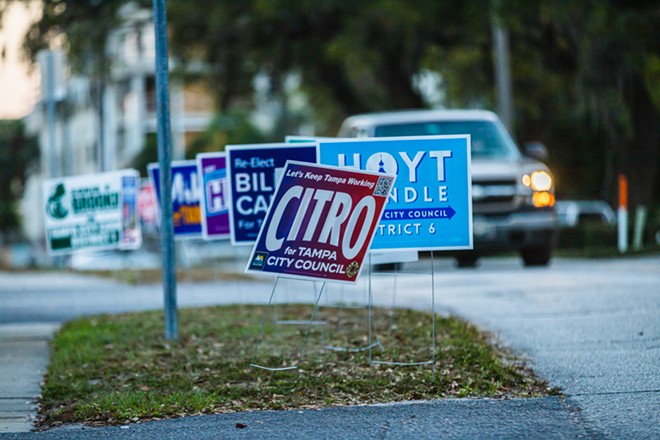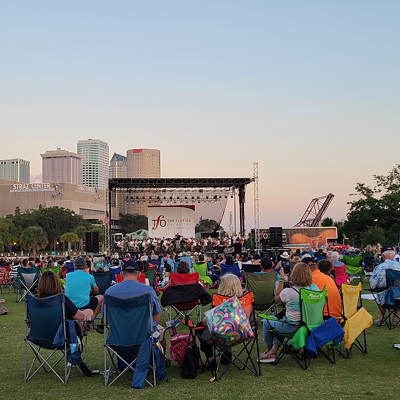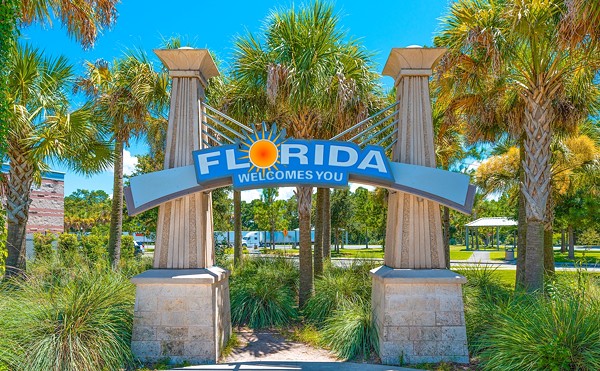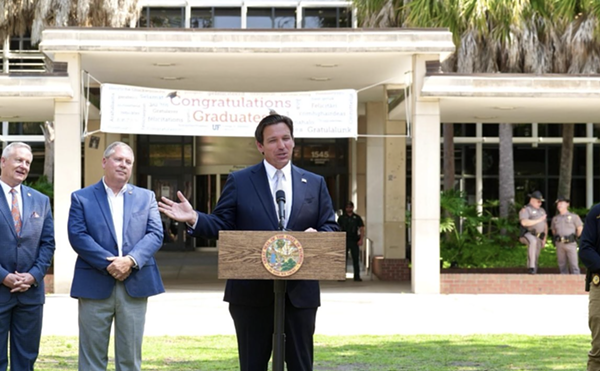Op-ed: It’s time to confront Tampa’s low voter turnout by timing local and national elections together
Tampa's commitment to this outdated practice resulted in an abysmal municipal election turnout last spring.
By Matt Newton on Tue, Sep 5, 2023 at 1:18 pm
Across the bay from Tampa, the City of St. Petersburg had a problem: its citizens were not voting in municipal elections. A paltry 19.7% of voters in the city’s electorate turned out for its November 2019 contest.
Leaders hunted for a solution. One that made sense was to change the date of local elections to align with national midterm elections—a proposition that would easily double (if not triple) voter participation.
The politically outspoken were conflicted. Some, including Creative Loafing Tampa Bay, recommended against it. Many were concerned it would make municipal elections less visible.
But the good people of St. Petersburg were not conflicted. Not even close. Given the choice, voters easily chose to re-calendar their municipal elections by nearly 70%. In hindsight, this supermajority vote was not terribly surprising. Nationally, clear majorities of Democrats (73%) and Republicans (61%) favor on-cycle local elections.
Such bipartisan agreement is rare these days. Which begs the question: why do so many cities, including the City of Tampa, continue to keep local elections separate from state and national contests?
The answer: history.
More specifically, the municipal reform movement of the 1900s. Members of this movement tried zealously to keep local politics as remote from state and national politics as possible.
On its face, this goal seems reasonable. If midterm elections and municipal elections are on the same day, communities risk permitting an inflammatory statewide candidate (i.e. Ron DeSantis) from influencing the makeup of a city’s dais.
But upon further examination—not quite. This assumes a deeply undemocratic premise: that some voters cannot be trusted.
The municipal reformers of the 1900s masterfully weaponized such distrust. And to advance their goal, they promoted a dangerous and familiar trope: the “Good Voter” versus the “Bad Voter.”
The “Good Voter” was a smart, sophisticated, business-minded voter with the city’s business interests at heart. The “Bad Voter” was an uneducated, unsophisticated, sock puppet controlled by partisan or malevolent forces.
Naturally, the “Good Voters” of the municipal reform movement were middle and upper-class white people. The “Bad Voters” were the commonly demonized: immigrants, people of color, and members of the lower class.
To the municipal reformers, Bad Voters could not be trusted to scramble the nuances of city businesses. They were either bought-and-paid-for or too uneducated, underpaid, or immature to understand complicated things like roads or clean water.
Accordingly, guided either by the municipal reform movement or other troubling elitist ideals, so-called Good Voters did everything they could to keep Bad Voters from spoiling local elections. And felt righteous doing so. This included introducing things as uncomplicated as poll taxes and literacy tests, to things as complicated as creating whites-only municipal parties to attempt side-stepping the 14th Amendment to prevent minorities from influencing elections.
(Please know that a White Municipal Party actually existed in the City of Tampa. Former Tampa Mayor Pam Iorio wrote an excellent article about it.).
In a healthy democracy, we understand there is no such thing as a Bad Voter. Accordingly, many of the techniques to keep so-called Bad Voters out of municipal elections have been abolished. But in many cities, these off-cycle municipal elections continue as relics from a shameful time.
Today in Tampa, the city’s commitment to this outdated practice resulted in an abysmal municipal election turnout this year: 13.65%. In these low turnout affairs, the data is irrefutable: residents over 65, white voters, and the wealthy are overrepresented.
Tampa’s municipal elections are hardly diverse. The voting share of white citizens dominate these contests with nearly 75% of the vote. In Tampa’s Presidential elections—which draw an average of six times the turnout—white voters are a more representative 63%. In these higher-turnout elections, participation by African American voters materially increases. The Hispanic share of voters nearly doubles. And Asian American share nearly triples.
Not accidentally, studies show that aligning local elections with more diverse turnout leads to the election of city officials who are more representative of the public and policies that are more in line with the preferences of all classes and races. Books published by scholars Sara Anzia, Brian Schaffner et al., and Zoltan Hajnal make this case with authority.
(Note: The Atlantic heavily quotes some of Professor Sara Anzia’s work in a recent article about election timing.)
Off-cycle municipal elections also poorly reflect the age of Tampa’s voters. Quite shockingly so. These contests are utterly dominated by voters over the age of 65—by an average of 52.6% of the vote. Voters under 40 make up an inexcusable 6.3% of turnout.
That aberration is easily fixed. A new election date could stabilize that dynamic to a more reflective 30.37% of under-40 voters and 22.99% of voters over retirement age.
And no, changing the election date will not create a partisan windfall one way or the other. The share of voters who identify as Democrats in the City of Tampa are essentially identical from off-cycle elections (57.95%) to midterm elections (56.66%). Scheduling elections to coincide with Presidential races would turn out only a marginally more Democratic voter (59.1%).
Nor is this a partisan issue. Democratic and Republican leaders are both pushing this same reform. For example California’s overwhelmingly Democratic state government passed a law mandating on-cycle local elections when local turnout falls below a certain threshold in 2015. Arizona’s overwhelmingly Republican state government then passed an almost identical law (though its supreme court later found the mandate violated the state constitution’s “home rule” language).
All voters are good voters. It is time that Tampa finally trusted the judgment of its citizens by making it easier and more convenient to vote—not harder. The City of St. Petersburg has chosen to do so. As have the cities of Los Angeles, San Francisco, San Jose, and Boulder.
Ultimately, these cities will save millions of dollars of taxpayer money and relieve other unnecessary burdens on public infrastructure.
But most importantly, they will reap the benefits of a healthy democracy. A local government that trusts its voters results in something truly vital for community: voters that trust the local government.
Matt Newton is a Tampa attorney board certified in City, County & Local Government Law, a La Gaceta columnist, and serves as chair of Community Tampa Bay.
Subscribe to Creative Loafing newsletters.
Follow us: Google News | NewsBreak | Reddit | Instagram | Facebook | Twitter
Leaders hunted for a solution. One that made sense was to change the date of local elections to align with national midterm elections—a proposition that would easily double (if not triple) voter participation.
The politically outspoken were conflicted. Some, including Creative Loafing Tampa Bay, recommended against it. Many were concerned it would make municipal elections less visible.
But the good people of St. Petersburg were not conflicted. Not even close. Given the choice, voters easily chose to re-calendar their municipal elections by nearly 70%. In hindsight, this supermajority vote was not terribly surprising. Nationally, clear majorities of Democrats (73%) and Republicans (61%) favor on-cycle local elections.
Such bipartisan agreement is rare these days. Which begs the question: why do so many cities, including the City of Tampa, continue to keep local elections separate from state and national contests?
The answer: history.
More specifically, the municipal reform movement of the 1900s. Members of this movement tried zealously to keep local politics as remote from state and national politics as possible.
On its face, this goal seems reasonable. If midterm elections and municipal elections are on the same day, communities risk permitting an inflammatory statewide candidate (i.e. Ron DeSantis) from influencing the makeup of a city’s dais.
But upon further examination—not quite. This assumes a deeply undemocratic premise: that some voters cannot be trusted.
The municipal reformers of the 1900s masterfully weaponized such distrust. And to advance their goal, they promoted a dangerous and familiar trope: the “Good Voter” versus the “Bad Voter.”
The “Good Voter” was a smart, sophisticated, business-minded voter with the city’s business interests at heart. The “Bad Voter” was an uneducated, unsophisticated, sock puppet controlled by partisan or malevolent forces.
Naturally, the “Good Voters” of the municipal reform movement were middle and upper-class white people. The “Bad Voters” were the commonly demonized: immigrants, people of color, and members of the lower class.
To the municipal reformers, Bad Voters could not be trusted to scramble the nuances of city businesses. They were either bought-and-paid-for or too uneducated, underpaid, or immature to understand complicated things like roads or clean water.
Accordingly, guided either by the municipal reform movement or other troubling elitist ideals, so-called Good Voters did everything they could to keep Bad Voters from spoiling local elections. And felt righteous doing so. This included introducing things as uncomplicated as poll taxes and literacy tests, to things as complicated as creating whites-only municipal parties to attempt side-stepping the 14th Amendment to prevent minorities from influencing elections.
(Please know that a White Municipal Party actually existed in the City of Tampa. Former Tampa Mayor Pam Iorio wrote an excellent article about it.).
In a healthy democracy, we understand there is no such thing as a Bad Voter. Accordingly, many of the techniques to keep so-called Bad Voters out of municipal elections have been abolished. But in many cities, these off-cycle municipal elections continue as relics from a shameful time.
Today in Tampa, the city’s commitment to this outdated practice resulted in an abysmal municipal election turnout this year: 13.65%. In these low turnout affairs, the data is irrefutable: residents over 65, white voters, and the wealthy are overrepresented.
Tampa’s municipal elections are hardly diverse. The voting share of white citizens dominate these contests with nearly 75% of the vote. In Tampa’s Presidential elections—which draw an average of six times the turnout—white voters are a more representative 63%. In these higher-turnout elections, participation by African American voters materially increases. The Hispanic share of voters nearly doubles. And Asian American share nearly triples.
Not accidentally, studies show that aligning local elections with more diverse turnout leads to the election of city officials who are more representative of the public and policies that are more in line with the preferences of all classes and races. Books published by scholars Sara Anzia, Brian Schaffner et al., and Zoltan Hajnal make this case with authority.
(Note: The Atlantic heavily quotes some of Professor Sara Anzia’s work in a recent article about election timing.)
Off-cycle municipal elections also poorly reflect the age of Tampa’s voters. Quite shockingly so. These contests are utterly dominated by voters over the age of 65—by an average of 52.6% of the vote. Voters under 40 make up an inexcusable 6.3% of turnout.
That aberration is easily fixed. A new election date could stabilize that dynamic to a more reflective 30.37% of under-40 voters and 22.99% of voters over retirement age.
And no, changing the election date will not create a partisan windfall one way or the other. The share of voters who identify as Democrats in the City of Tampa are essentially identical from off-cycle elections (57.95%) to midterm elections (56.66%). Scheduling elections to coincide with Presidential races would turn out only a marginally more Democratic voter (59.1%).
Nor is this a partisan issue. Democratic and Republican leaders are both pushing this same reform. For example California’s overwhelmingly Democratic state government passed a law mandating on-cycle local elections when local turnout falls below a certain threshold in 2015. Arizona’s overwhelmingly Republican state government then passed an almost identical law (though its supreme court later found the mandate violated the state constitution’s “home rule” language).
All voters are good voters. It is time that Tampa finally trusted the judgment of its citizens by making it easier and more convenient to vote—not harder. The City of St. Petersburg has chosen to do so. As have the cities of Los Angeles, San Francisco, San Jose, and Boulder.
Ultimately, these cities will save millions of dollars of taxpayer money and relieve other unnecessary burdens on public infrastructure.
But most importantly, they will reap the benefits of a healthy democracy. A local government that trusts its voters results in something truly vital for community: voters that trust the local government.
Matt Newton is a Tampa attorney board certified in City, County & Local Government Law, a La Gaceta columnist, and serves as chair of Community Tampa Bay.
Subscribe to Creative Loafing newsletters.
Follow us: Google News | NewsBreak | Reddit | Instagram | Facebook | Twitter
Tags:

WE LOVE OUR READERS!
Since 1988, CL Tampa Bay has served as the free, independent voice of Tampa Bay, and we want to keep it that way.
Becoming a CL Tampa Bay Supporter for as little as $5 a month allows us to continue offering readers access to our coverage of local news, food, nightlife, events, and culture with no paywalls.
Scroll to read more Columns articles
Newsletters
Join Creative Loafing Tampa Bay Newsletters
Subscribe now to get the latest news delivered right to your inbox.

















